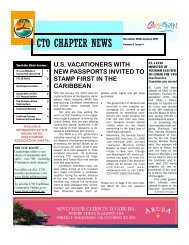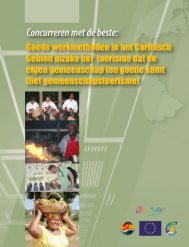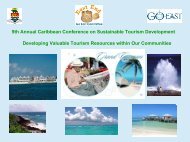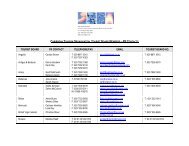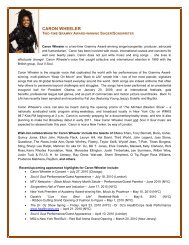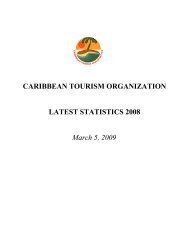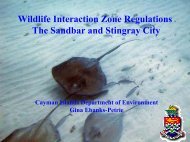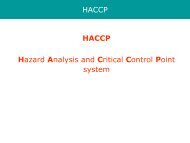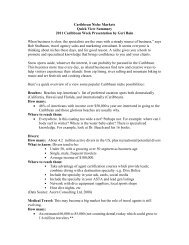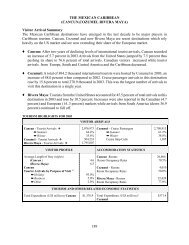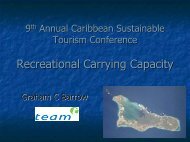Trinidad and Tobago's Experience - Caribbean Tourism Organization
Trinidad and Tobago's Experience - Caribbean Tourism Organization
Trinidad and Tobago's Experience - Caribbean Tourism Organization
Create successful ePaper yourself
Turn your PDF publications into a flip-book with our unique Google optimized e-Paper software.
TRINIDAD AND TOBAGO’S<br />
TSA EXPERIENCE<br />
Presented by Sharifa Ali-Abdullah<br />
CTO TSA Workshop<br />
February 7th-9th, 2007<br />
Barbados
Presentation Format<br />
• The Big Picture – Vision 2020<br />
• Economic Structure<br />
• <strong>Tourism</strong>’s Contribution<br />
• Search for Economic Impact Studies<br />
• Chicken <strong>and</strong> Egg Situation<br />
• WTTC’s Simulated TSA Model<br />
• Way Ahead
T&T’s GROWTH & DEVELOPMENT STRATEGY
Five Development Pillars<br />
•o<br />
Guiding Vision<br />
From Draft DNSP<br />
VISION 2020<br />
By the year 2020 <strong>Trinidad</strong> <strong>and</strong> Tobago will be a united,<br />
resilient, productive, innovative <strong>and</strong> prosperous nation with a<br />
caring, fun-loving society comprising healthy, happy welleducated<br />
people <strong>and</strong> built on the enduring attributes of selfreliance,<br />
respect, tolerance, equity <strong>and</strong> integrity ……..<br />
Innovative People<br />
Pre-primary, Primary<br />
& Secondary Education<br />
Tertiary Education<br />
Skills Development & Training<br />
Science, Technology &<br />
Innovation<br />
Health<br />
HIV/AIDS<br />
Housing<br />
Caring Society<br />
Youth, Sport & Recreation<br />
Labour & Social Security<br />
Poverty Alleviation & Social<br />
Services<br />
Gender & Development<br />
Regional Development &<br />
Sustainable Communities<br />
Competitive<br />
Business<br />
International Relations,<br />
Regional Cooperation &<br />
Trade<br />
Macroeconomy & Finance<br />
Industry & Entrepreneurship<br />
Energy<br />
<strong>Tourism</strong><br />
Agriculture<br />
Financial Services<br />
Sound<br />
Infrastructure &<br />
Environment<br />
Environment<br />
Infrastructure<br />
Public Utilities<br />
Effective<br />
Government<br />
National Security &<br />
Public Safety<br />
Law Administration &<br />
Legal Affairs<br />
Governance &<br />
Institutional Structures<br />
for Development<br />
Administration of Justice
Some Macroeconomic Goals<br />
• Macroeconomic stability<br />
– Robust growth<br />
– Single digit inflation<br />
– Strategy of Full Employment<br />
Where are the jobs<br />
coming from?
T&T’s Economic Structure<br />
Energy<br />
41%<br />
Services<br />
51%<br />
Manufacturing<br />
7%<br />
Agriculture<br />
1%
Services<br />
Education <strong>and</strong><br />
Cultural Services<br />
4%<br />
Personal Services<br />
Electricity <strong>and</strong><br />
2%<br />
Water<br />
3% Construction<br />
17%<br />
Government<br />
9%<br />
Finance,<br />
Insurance <strong>and</strong><br />
Real Estate<br />
28%<br />
Transport,<br />
Storage <strong>and</strong><br />
Communication<br />
14%<br />
Hotels <strong>and</strong><br />
Guesthouses<br />
1%<br />
Distribution <strong>and</strong><br />
Restaurants<br />
22%<br />
Is this<br />
accurate?
Energy Sector Does Not Create …<br />
Jobs<br />
Community,<br />
social <strong>and</strong><br />
personal services<br />
31%<br />
Not stated<br />
0.4%<br />
Agriculture<br />
5%<br />
Petroleum <strong>and</strong><br />
Gas<br />
4%<br />
Other Mining <strong>and</strong><br />
quarrying<br />
0.2% Other<br />
Manufacturing<br />
9%<br />
Electricity <strong>and</strong><br />
water<br />
1%<br />
Financing,<br />
insurance real<br />
estate<br />
7%<br />
Transport,<br />
storage <strong>and</strong><br />
communication<br />
7%<br />
Wholesale <strong>and</strong><br />
retail<br />
18%<br />
Construction<br />
18%
Vision for <strong>Tourism</strong><br />
By the year 2020, the <strong>Trinidad</strong> <strong>and</strong> Tobago’s tourism<br />
product will be:<br />
• A significant economic sector contributing significantly<br />
to the nation’s GDP, through job creation <strong>and</strong> increased<br />
revenues;<br />
• Driven by a uniquely differentiated, internationally<br />
competitive product,<br />
• Complemented by comprehensive, fully functional<br />
physical infrastructure <strong>and</strong> a modern, competitive<br />
institutional framework<br />
• Supported by the people of <strong>Trinidad</strong> <strong>and</strong> Tobago.
Vision 2020<br />
• Need to quantify the impact of tourism on<br />
the economy more accurately<br />
• Traditional proxy of hotel <strong>and</strong> guest house<br />
sector underestimated impact of tourism<br />
resulting in low investment, little credibility<br />
for the sector<br />
• Intuitively knew contribution was higher<br />
• Tobago – tourism one of the leading<br />
sectors – no economic impact studies
Search is on…<br />
• CSO<br />
- Started some preliminary work but TSA not a priority – tourism<br />
not a priority!<br />
- Resource constraints<br />
- Ongoing project – no timelines<br />
• CTO<br />
- TSA’s not done<br />
- Some assistance with exit survey<br />
- Pointed to some preliminary work done on economic impact of<br />
tourism<br />
• Stats Canada<br />
– Advised that the UNWTO model was the best<br />
– Indicated that it took 5 years for Canada to produce its first TSA
Expediency<br />
• Central Statistical Office had started some<br />
preliminary work in 2003<br />
• Need for measurement was critical to<br />
inform the Vision 2020 project – national<br />
development agenda – national strategic<br />
plan<br />
• Dedicated ministry for tourism<br />
• Minister of <strong>Tourism</strong> with training in tourism<br />
• <strong>Tourism</strong> no longer “ the outside child”
Attitudes about <strong>Tourism</strong><br />
• Energy sector dominates<br />
• <strong>Tourism</strong> was viewed as servitude<br />
• Not taken seriously<br />
• Not given the prominence <strong>and</strong> acceptance<br />
• Available stats indicated that it contributed 1% of<br />
the country’s GDP!!!<br />
• Why bother with tourism at all?<br />
• Government ministers dismissing tourism in<br />
<strong>Trinidad</strong>
Chicken <strong>and</strong> Egg Situation<br />
Dilemma<br />
Work on full TSA <strong>and</strong> get results in five<br />
years <strong>and</strong> not have information for advocacy?<br />
Implement an interim measure to quantify<br />
the contribution of tourism to the economy<br />
<strong>and</strong> negotiate for more resources?
Solution<br />
• Search for interim measure<br />
– Public statement<br />
– Participation at UNWTO TSA Conference<br />
• World Travel <strong>and</strong> <strong>Tourism</strong> Council <strong>and</strong><br />
Oxford Economic Forecasting<br />
• Simulated model<br />
• Could be done in six months<br />
• Needed for Vision 2020 at national level<br />
<strong>and</strong> tourism industry
Process<br />
• Set up inter-agency team<br />
– Central Statistical Office<br />
– Tobago House of Assembly – PRDI<br />
– Ministry of <strong>Tourism</strong><br />
– Central Bank<br />
– TIDCO
Process<br />
• Agree on Methodology<br />
– Stats Canada indicated that the WTTC’s<br />
methodology was applied to their tourism<br />
industry <strong>and</strong> the results were close to the<br />
UNWTO’s RMF<br />
– Policy decision – second best option<br />
– Part of problem was limited knowledge of the<br />
UNWTO’s RMF
Process<br />
• Launch<br />
• Data Inventory – CSO, CB, TIDCO, MOT<br />
• Policy Meetings – all stakeholders<br />
• Preliminary Results – reviewed by team<br />
• Assumptions modified<br />
• Some triangulation attempted – employment<br />
from CSO’s labour force surveys<br />
• Final results presented
WTTC’s Methodology<br />
• Conceptually follows the UNWTO’s RMF<br />
for TSA development<br />
• Not use the 10 TSA Tables<br />
• Model the tourism economy similar to that<br />
of the national economy using the national<br />
income equation<br />
NI=C + I + G + X – M<br />
<strong>Tourism</strong> GDP is calculated for each of the<br />
components of NI using appropriate ratios
WTTC’s Methodology<br />
• Ratios derived from basic input-output<br />
table produced by CSO<br />
• Extensive data used – T&T sources<br />
• Assumptions were finalised by interagency<br />
team<br />
• Triangulation of results
Benefits<br />
• Advocacy<br />
– THA used document in negotiating with the Prime<br />
Minister for resources for Tobago<br />
– Tobago quotes frequently from document<br />
• Budget tripled in first year<br />
• Investment increased substantially<br />
• New hotels, investment in tourism infrastructure<br />
• Industry re-positioned <strong>and</strong> acceptance increased<br />
• TSA awareness enhanced
Some Caveats<br />
• Of course – it is a model <strong>and</strong> assumptions <strong>and</strong> in<br />
some cases estimation can produce less than<br />
robust results<br />
• Limitations to cross country comparisons since<br />
methodologies differ<br />
• Models need to be updated – by skilled <strong>and</strong><br />
trained personnel - update currently being done<br />
• No one from original team is involved in the<br />
update
Way Forward<br />
• Support the full TSA using the UNWTO<br />
RMF<br />
• Set up inter-agency platform<br />
• Ensure CSO has the resources<br />
• Develop clear implementation strategy<br />
• Develop separate TSA for Tobago



